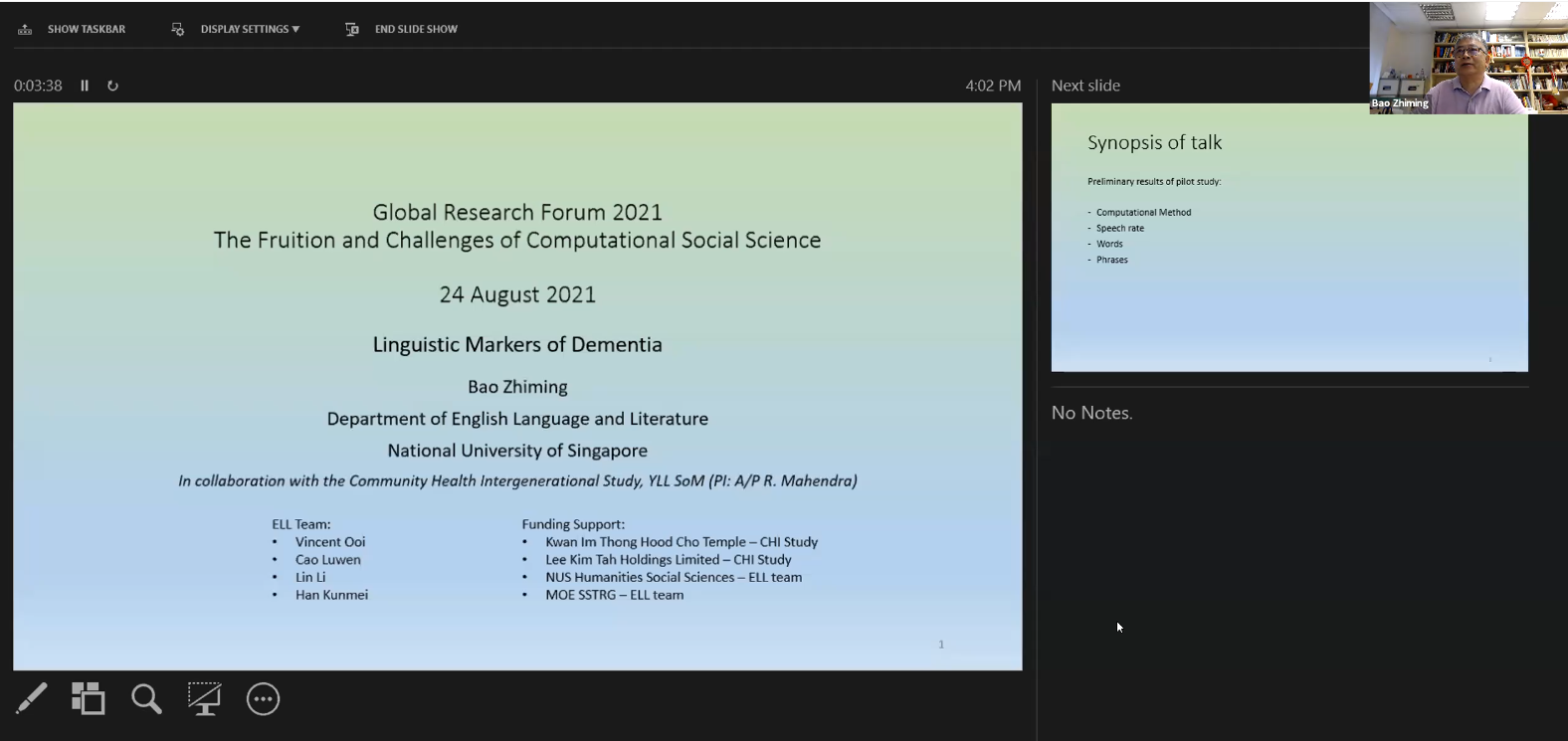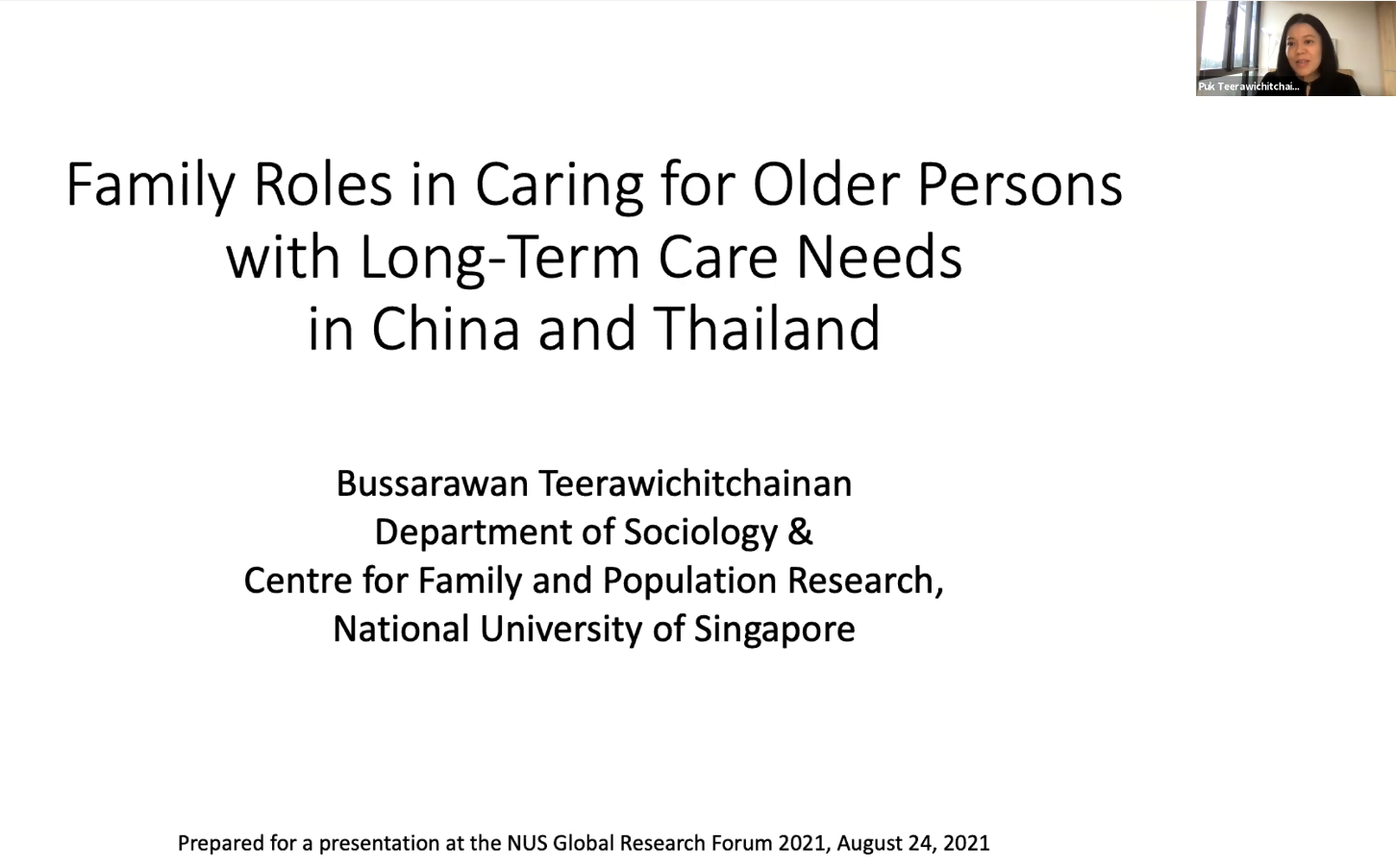FASS Global Research Forum: ‘Health and Social Support’ – Presentations from NUS Departments of English Language and Literature, Sociology, Social Work, and Geography
September 23, 2021
The fourth theme of the Global Research Forum, ‘Health and Social Support’, featured research by Professor Bao Zhiming (NUS Department of English Language and Literature), Associate Professor Vincent Chua (NUS Sociology and Centre for Family and Population Research) and Associate Professor Irene Y.H. Ng (NUS Social Work and Social Service Research Centre), Associate Professor Bussarawan ‘Puk’ Teerawichitchainan (NUS Sociology and Centre for Family and Population Research), and Associate Professor Wang Yi-Chen (NUS Geography).

Prof Bao presented on ‘Linguistic Markers of Dementia’, where he shared his work for the Community Health Intergenerational (CHI) study and related research. The research team analyzed English and Singlish speech data from 36 Singaporeans, 28 of whom were healthy and 8 of whom displayed signs of mild cognitive impairment. Content words (nouns, verbs, adjectives, adverbs) and function words (articles, pronouns, prepositions, modals etc.) were labeled and the ratio of these word types to each other and the lexical density of sentences were examined for each participant. Amount, frequency, and complexity of noun phrases and verb clusters were also examined. A ten percent decline in speech rate was found among those with mild cognitive impairment, and while there was no significant difference in complexity, ratio, and amount content words among this group, their usage of noun and verb phrases declined.

Assoc Prof Chua and Assoc Prof Ng presented on ‘Finding vs. Being Found: Unequal Network Pathways to Jobs among Young Adults’, based on research conducted as part of their Social Science Research Thematic Grant where they focused on work histories, conditions, and outcomes of lower-income young adults, in comparison with high-income young adults in Singapore. They explored how young adults get jobs, and which methods are more prevalent and effective. They also examined whether there are differences between groups in the methods used and the outcomes.
Assoc Prof Chua explained that job quality has become increasingly polarized, with the “good” jobs providing living to high wages, benefits, and opportunities for advancement and training, and the “bad” jobs being dead-end with low to minimum wages. This creates an unacceptably large population of working poor. The decrease in middle-range jobs and rise of market-mediated employment such as temporary work has caused increased insecurity among vulnerable populations of workers, with heightened social inequality between these groups. Since Singapore is a meritocracy that places a high degree of weight on formal qualifications, the researchers predict that well-educated groups will favor their educational qualifications when job-searching, with greater success, while the less-educated will employ informal strategies like job contacts, and jobs found through these strategies tend to be of poorer quality.
The research team surveyed 1,610 working adults aged 21 to 38, dividing them into a target group with an education level of polytechnic graduate and below, and a household income of below S$5,000, and a comparison group of polytechnic graduates with household income of at least $5,000, as well as university graduates. They found that in the target group, 46.1% got their current job through a personal contact or network, and in the comparison group, only 37.5% did. They also found that the target group had to be more persistent in their job hunt, employing more methods and spending more time. In addition, the target group must proactively mobilize their social networks to job search, whereas the control group is more often recruited with no effort, in what Assoc Prof Chua described as ‘non-searching’. Furthermore, the target group tended to rely on strong ties to friends and family, while the control group made use of weak ties to coworkers and acquaintances.

Assoc Prof Teerawichitchainan presented her study on ‘Family Roles in Caring for Older Persons with Long-term Care Needs in China and Thailand’. She looked at who among elderly Chinese and Thais is more likely to need long-term care (LTC), the extent to which older adults with LTC needs receive care support and what determines whether they will receive it, who provides their LTC and what determines the type of providers, and how China and Thailand compare and contrast in LTC needs and receipt. Assoc Prof Teerawichitchainan explained that she focused on China and Thailand because they are two of Asia’s most rapidly ageing middle-income countries and possess different kinship systems (China is patrilineal and Thailand is bilateral), and their state and private LTC systems are starting to develop. Moreover, Asians currently entering old age are more vulnerable to disabilities than previous generations, and population ageing, smaller families, and out-migration compound the risks of social reliance on family-based LTC.
Her study used data from Wave 3 (2015) the China Health and Retirement Longitudinal Study (CHARLS) and the 2017 round of the Survey of Older Persons in Thailand (SOPT). She looked at people aged 60 and above, with LTC needs and receipt and type of primary caregiver as dependent variables, and living arrangements, household wealth, and number and gender of children as independent variables. The study’s socio-demographic variables included age, gender, marital status, education, and location.
Assoc Prof Teerawichitchainan found that in both countries, residents who are older, unmarried, and uneducated urban residents have higher LTC needs. In addition, women in China have increased LTC needs, as do Thai residents living with their children. She also found that older residents received more care as they aged, while less educated ones received less care in general, and older people living alone are least likely to receive care. Moreover, those with at least two daughters are more likely to be cared for by their children than by their spouse.
The study also revealed that two thirds of older Thais and Chinese in need of LTC received it, with intergenerational co-residence being a key factor, and that wealth disparity in LTC receipt can be seen in Thailand, but not China. Assoc Prof Teerawichitchainan advised both countries continue to provide assistance for family caregivers and promote gender equality in caregiving roles. She stressed that affordable institutional care be made available for frail seniors who do not have family members that can assist them, and that the state also provide housing assistance for families that encourages children to live with or close to elderly parents.

Assoc Prof Wang presented her study, ‘Geospatial Analysis of Liver Fluke Infection Risks in Thailand’. She explained that these infections are caused by consumption of raw seafood primarily along the Mekong river and disproportionally affect the marginalized in developing regions. The species of parasite she focuses on is called opisthorchis viverrini (Ov) and is endemic in Thailand, Vietnam, Cambodia, and Laos. The research team looked at over 90 villages in Thailand to find out the effect of the surrounding land use composition and dominance of human settlements on Ov prevalence variation. They used remote sensing to derive the land use distribution surrounding the villages. Land use was divided into six classes: water, farmland with high water content, farmland with medium water content, farmland with low water content, built up and bare land, and vegetation. They also quantified land use patterns with landscape metrics, looking at the similarities and variations in land compositions, patch densities, shapes, and dominances.
The study found that the dominance of a large water related land use patch might provide suitable habitats for the Ov intermediate hosts (Cyprinid fish and Bithynia snails) in the village surroundings, potentially contributing to high prevalence for the infections. The researchers also investigated the connectivity between the human host habitats and the snail host habitats. They examined how different degrees of habitat patch connections across the study sites affect the overall parasitic infections in Bithynia snails, collecting snails and employing Geographic Information System (GIS) mapping and network analysis at three different sites.
The project also examined the role of reservoirs, socio-economic behavioral factors, and healthcare focus variation. This involved fecal sample collections and surveys at four villages next to a reservoir. This research revealed that differences in dam construction and waterbody types affects exposure to infections. The research team also found that there was a lack of awareness of liver fluke infection among the residents, the elderly were more prone to infection, and that more men consumed raw fish dishes because more of them ate those dishes with their male friends when socializing. Assoc Prof Wang explained that health centers also play a key role in reducing infections, and the project included interviews with health center personnel in the area of study to determine the effectiveness of their prevention programs.
Watch the video from Theme 4: ‘Health and Social Support’ here.

